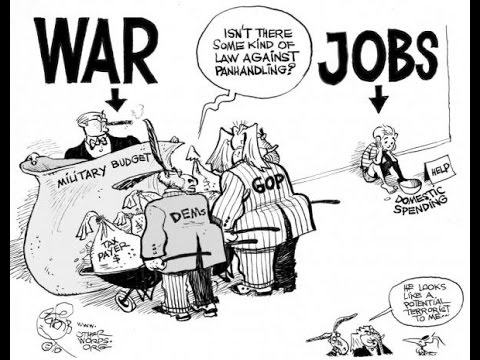More Money, Fewer Jobs - The Stubborn Truth About Employment and the Defense Industry
By Nia Harris, Cassandra Stimpson, Ben Freeman

August 16, 2019 "Information Clearing House" - A Marilyn has once again seduced a president. This time, though, it's not a movie star; it's Marillyn Hewson, the head of Lockheed Martin, the nation's top defense contractor and the largest weapons producer in the world. In the last month, Donald Trump and Hewson have seemed inseparable. They "saved" jobs at a helicopter plant. They took the stage together at a Lockheed subsidiary in Milwaukee. The president vetoed three bills that would have blocked the arms sales of Lockheed (and other companies) to Saudi Arabia. Recently, the president's daughter Ivanka even toured a Lockheed space facility with Hewson.
On July 15th, the official White House Twitter account tweeted a video of the Lockheed CEO extolling the virtues of the company's THAAD missile defense system, claiming that it "supports 25,000 American workers." Not only was Hewson promoting her company's product, but she was making her pitch—with the weapon in the background—on the White House lawn. Twitter immediately burst with outrage over the White House posting an ad for a private company, with some calling it "unethical" and "likely unlawful."
None of this, however, was really out of the ordinary as the Trump administration has stopped at nothing to push the argument that job creation is justification enough for supporting weapons manufacturers to the hilt. Even before Donald Trump was sworn in as president, he was already insisting that military spending was a great jobs creator. He's only doubled down on this assertion during his presidency. Recently, overriding congressional objections, he even declared a national "emergency" to force through part of an arms sale to Saudi Arabia that he had once claimed would create more than a million jobs. While this claim has been thoroughly debunked, the most essential part of his argument—that more money flowing to defense contractors will create significant numbers of new jobs—is considered truth personified by many in the defense industry, especially Marillyn Hewson.
The facts tell a different story.
Lockheed Locks Down Taxpayer Dollars, While Cutting American Jobs
To test Trump's and Hewson's argument, we asked a simple question: When contractors receive more taxpayer money, do they generally create more jobs? To answer it, we analyzed the reports of major defense contractors filed annually with the U.S. Securities and Exchange Commission (SEC). Among other things, these reveal the total number of people employed by a firm and the salary of its chief executive officer. We then compared those figures to the federal tax dollars each company received, according to the Federal Procurement Data System, which measures the "dollars obligated," or funds, the government awards company by company.
We focused on the top five Pentagon defense contractors, the very heartland of the military-industrial complex, for the years 2012 to 2018. As it happened, 2012 was a pivotal year because the Budget Control Act (BCA) first went into effect then, establishing caps on how much money could be spent by Congress and mandating cuts to defense spending through 2021. Those caps were never fully adhered to. Ultimately, in fact, the Pentagon will receive significantly more money in the BCA decade than in the prior one, a period when the American wars in Afghanistan and Iraq were at their heights.
In 2012, concerned that those caps on defense spending would cut into their bottom lines, the five top contractors went on the political offensive, making future jobs their weapon of choice. After the Budget Control Act passed, the Aerospace Industries Association—the leading trade group of the weapons-makers—warned that more than one million jobs would be at risk if Pentagon spending were cut significantly. To emphasize the point, Lockheed sent layoff notices to 123,000 employees just before the BCA was implemented and only days before the 2012 election. Those layoffs never actually happened, but the fear of lost jobs would prove real indeed and would last.
Consider it mission accomplished, since Pentagon spending was actually higher in 2018 than in 2012 and Lockheed received a sizeable chunk of that cash infusion. From 2012 to 2018, among government contractors, that company would, in fact, be the top recipient of taxpayer dollars every single year, those funds reaching their zenith in 2017, as it raked in more than $50.6 billion federal dollars. By contrast, in 2012, when Lockheed was threatening its employees with mass layoffs, the firm received nearly $37 billion.
So what did Lockheed do with those additional $13 billion taxpayer dollars? It would be reasonable to assume that it used some of that windfall (like those of previous years) to invest in growing its workforce. If you came to that conclusion, however, you would be sorely mistaken. From 2012 to 2018, overall employment at Lockheed actually fell from 120,000 to 105,000, according to the firm's filings with the SEC and the company itself reported a slightly larger reduction of 16,350 jobs in the U.S. In other words, in the last six years Lockheed dramatically reduced its U.S. workforce, even as it hired more employees abroad and received more taxpayer dollars.
|
Are You Tired Of The Lies And Non-Stop Propaganda? |

